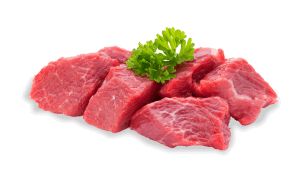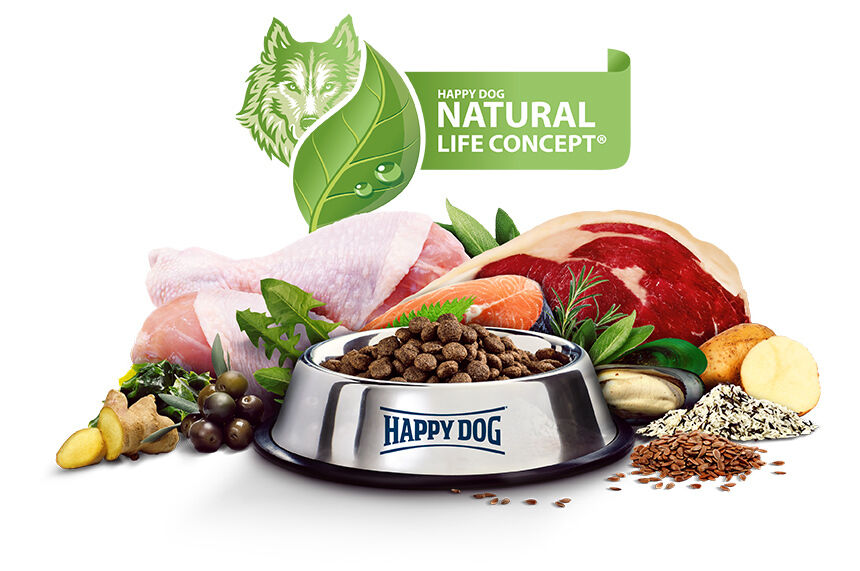Many other dog owners fall between these two extremes, however, so perhaps you are also wondering how much meat your dog actually needs. Here you can find out what a balanced diet for a dog should contain, and what part meat should play in it.

How much meat does my dog actually need?
‘Dogs need meat!’ – you’ve probably heard other dog owners say. It is true that dogs are descended from wolves, and that wolves mainly eat meat. But it is also true that today’s domestic dogs are quite different to wolves. This is because wolves have developed into dogs over many tens of thousands of years, and in that time their systems have adjusted to different conditions and needs. This is particularly true with respect to energy requirements, where the lives of most dogs today are very different to that of their common ancestors. Your dog probably doesn’t have to cover 50 km every day to patrol its territory or hunt its prey. A typical domestic dog will rarely run more than seven or eight km daily. For that reason, your dog will generally need a moderate energy supply with less fat and more protein. Most importantly, they need a balanced ratio of meat, carbohydrates and fibre.
How can I ensure a balanced diet for my dog?
At Happy Dog we pay particular attention to providing varied, high-value animal protein from meat and offal. So with regard to your dog’s protein requirements, you get your money’s worth: The proportion of pure animal protein in Happy Dog dry food is up to 90% of the total protein and so significantly higher than many other brands. To give your dog a balanced meat diet, we supplement this with optimal amounts of carbohydrates from potato or grains, important sources of fibre, and vital vitamins and minerals. We follow nature’s example and have developed the Happy Dog Natural Life Concept®, which is based on the fact that dogs stem from wolves, but also adapted to meet the needs of today’s dogs. In scientific terms, it offers dogs a combination of all the vital elements they require for meaningful nutrition. In this way the metabolism and the entire system receives optimal and species-appropriate support. At Happy Dog we also add natural ingredients such as herbs, apple, mussels and linseed to our food, to provide your dog with the necessary ingredients for a long and healthy life.
What does the ‘meat content’ in dog food actually refer to?
Did you know that there is no scientific definition for the term ‘meat content’? Because of this, packaging can contain widely differing information. How has this come about? A decisive factor in describing the percentage of meat content is, in addition to the basic amount (pure meat or the total amount of fresh ingredients originating from animals), is whether fresh meat or dried raw ingredients are used. Fresh meat and offal contain on average 70% water. In the heating process during the production of dried meat, most of the water is extracted. Around 30% dried meat remains. This can be transported and stored using more environmentally friendly and more sustainable methods. Fresh meat is processed without the preceding drying process. The water content in the meat is only extracted during the production processes for dehydrated food. A reputable statement on foodstuffs will define the meat content as the proportion of animal protein in relation to the total protein in the dog food.
It is therefore easy to see why it is difficult to compare different statements regarding meat content. Particularly in dog food based on dried raw ingredients, the stated meat content is often significantly lower. This is due to dried meat having a very low water content. Even when exclusively fresh ingredients are used to make the dog food, at the end only the dried percentage remains. In order for the amount of animal protein contained in the dog food of different brands to be compared, the dry content would have to be declared in a standardised way. With dog food, in particular, manufacturers can use differing data for the statement of ingredients. It might therefore seem at first glance as if one dog food has a higher meat content than another. But this depends on what is being classed as ‘meat’: Is it pure meat or the total amount of fresh ingredients from the animal? Also, it is important to know whether the ingredients are fresh or dried when they are processed. At Happy Dog we only state the real amount of dried meat. The meat content in our products is therefore significantly higher than it seems at first glance.
The meat content in Happy Dog dog food
In our dog food, we use meat and nutritious offal from freshly slaughtered, food-grade animals. We take care to ensure the best quality sources for our raw ingredients. For dogs, it is important that the amount of animal protein or meat is significantly higher than the amount of plant-based protein. At Happy Dog, the amount of animal protein is up to 90% of the total protein. Discover the whole range of Happy Dog dry food varieties.
Wet dog food with a high proportion of meat
Our wet dog food also has a high proportion of meat and gives your pet everything they need. Our Happy Dog wet food with high meat content is available in 10 different varieties. So there is sure to be a variety there to suit your dog.
Grain-free dog food with high meat content
Does your dog have a sensitive stomach, or has your vet diagnosed a food intolerance? Then our wide range of Happy Dog grain-free varieties may be just the right food for your dog. We naturally take great care to ensure that our grain-free dry food also provides your dog with sufficient meat. Many of our varieties are based on animal protein sources (mono protein) and are made with no grain or potato. Does your dog have a food intolerance to potato? We can also help here, with our Happy Dog Sensible Piemonte and our Mini Piemonte, where we use Italian chestnuts as the exclusive carbohydrate source. Discover our grain-free dog food.
Compare dry and wet food - here’s how!
As mentioned before, the difference in water content between dry and wet food makes it difficult to compare nutrient content such as the protein content. A meaningful comparison can only be made by determining the ‘dry material’ (DM) – that is, the quantity of nutrients in the substance in a 100% dry state.
This sample calculation shows how the nutrient contents can be compared.
Compare the protein content of two renal diet foods – A (dry food) and B (wet food)
Renal diet A (dry food) contains:
10% moisture, 12.5% crude protein. 100% Original food - 10% water = 90% DM.
12.5 (crude protein) : 90 (DM) x 100 = 13.8% crude protein in the DM
Renal diet B (wet food) contains:
61% moisture with 6.8% crude protein. 100% Original food - 61% water = 39% DM.
6.8 (crude protein) : 39 (DM) x 100 = 17.4% crude protein in the DM
The example shows that the wet food clearly contains more protein than it appears to at first sight. It is therefore important to carry out the appropriate conversion if you wish to compare wet and dry food.



